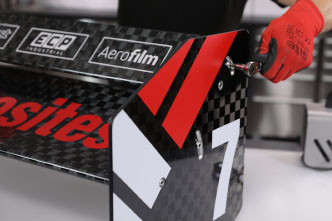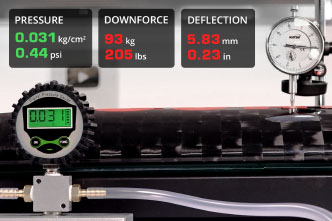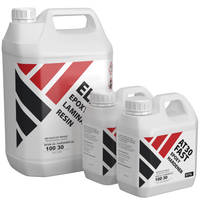Heb je hulp of advies nodig?+44 (0)1782 454499
VIDEO'S IN DEZE SERIE
Deze video is deel 1 van een serie in 2 delen:PRODUCTEN GEBRUIKT IN DIT PROJECT
Hoewel dit niet per se een uitputtende lijst is, werden de volgende gereedschappen en materialen, geleverd door Easy Composites, in dit project gebruikt.
De hoeveelheid die hieronder wordt weergegeven, is de geschatte hoeveelheid die in het project wordt gebruikt, afgerond naar de dichtstbijzijnde beschikbare kitgrootte of hoeveelheid.
MATERIALEN & VERBRUIKSARTIKELEN
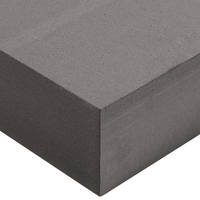
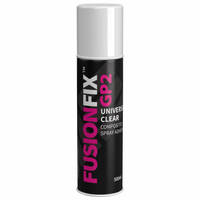
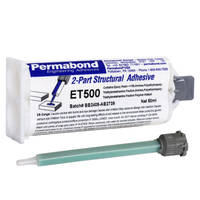
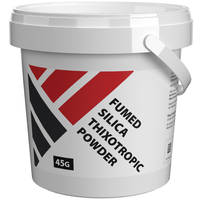
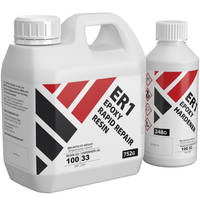
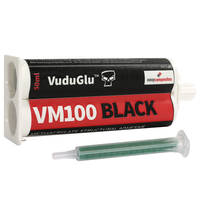
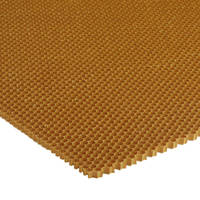
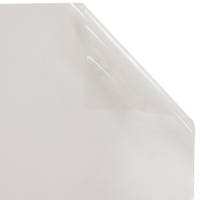
GEREEDSCHAP & UITRUSTING
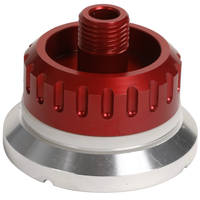
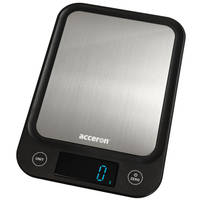
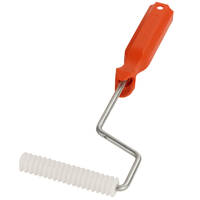
VERBRUIKSARTIKELEN VOOR VACUÜMZAKKEN
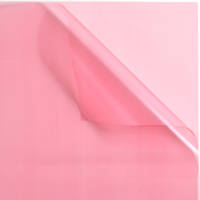
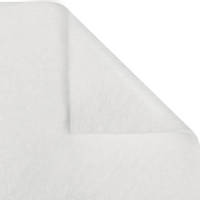
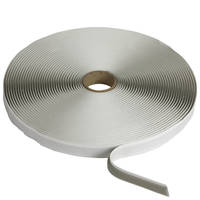
ANCILLARIES
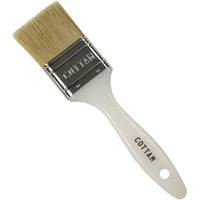
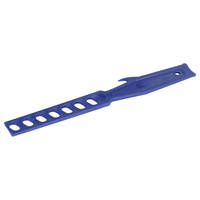
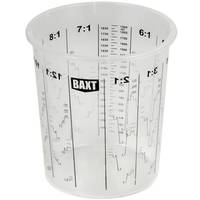
VERSTERKINGEN
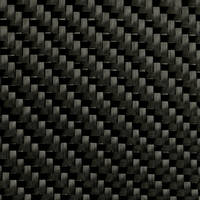
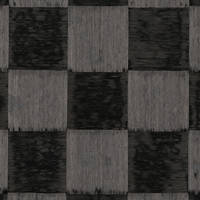
VIDEO HANDLEIDING
Vormloze Motorsportvleugelconstructie
In deze instructievideo behandelen we een vormloze methode om een aerodynamische achtervleugel te maken die ideaal is voor middelmatige tot lage motorsporttoepassingen. Hierbij wordt gebruikgemaakt van een kern van XPS-polystyreen en Mylar-folie om het gladde oppervlak te creëren. Het maken van structurele eindplaten en inzetstukken komt ook aan bod.
INLEIDING
Downforce producerende vleugels zijn een essentieel onderdeel van veel motorsportvoertuigen. Deze video demonstreert hoe je een effectieve aero-achtervleugel maakt met behulp van een eenvoudige constructiemethode zonder mal.
High-end motorsport zoals F1 en in massa geproduceerde vleugels zullen over het algemeen nog steeds gebruik maken van een gegoten constructiemethode, dus deze vormloze techniek is ideaal voor motorsport op clubniveau, Time Attack, Formula Student en andere vergelijkbare motorsportdisciplines waar een lichte maar sterke methode voor het maken van een eenmalige vleugel of een vleugel met een laag volume de voorkeur heeft.
Hoewel het schuimkernmateriaal en de inzetstukken die tijdens deze video zijn gemaakt, zijn gesneden met CNC-machines, kunnen ze ook gemakkelijk zonder CNC-apparatuur worden gesneden, waardoor deze methode van vleugelbouw toegankelijk blijft.
WAT JE ZULT LEREN
De volgende belangrijke gebieden worden in deze instructievideo behandeld:
- Hoe de vleugelkern profileren met een hetedraadfrees.
- Geschikte harde punten en invoegingen maken.
- Hoe de koolstofvezel op de kern te lamineren en vacuüm te zamelen met Mylar.
- Hoe lichtgewicht eindplaten maken met Nomex .
WAT JE NODIG HEBT
Materialen en apparatuur die nodig zijn om het project te voltooien
XPS polystyreenschuim - Om in vorm te snijden voor de vleugelkern. Gekozen vanwege de gladde afwerking, het lichte gewicht en de mogelijkheid om met een hete draad te snijden.
Heetdraadsnijder - Om de vleugelprofielen in de gewenste vorm te snijden. Dit kan met een eenvoudige handboogdraadsnijder of een meer geavanceerde meerassige CNC-draadsnijder.
Aluminium plaat of profiel - Voor het vervaardigen van inzetstukken en harde punten. Aluminium wordt gebruikt vanwege de goede allround sterkte, het gemak van machinale bewerking en het relatieve gewicht in vergelijking met andere metalen.
Afplakband - Helpt de randen van touw Spread touw te binden zodat deze niet uit elkaar valt.
88 g Spread touw Carbon Fibre Fabric - Produceert een gladde en hoogwaardige cosmetische afwerking als oppervlaktelaagstof op de vleugel.
Papierrol - Om de eerste laag wapening te scheiden wanneer deze wordt opgerold voor gebruik.
Mylar Release Film - Deze film is essentieel voor het gladde oppervlak van de vleugel en met zijn dikte, flexibele eigenschappen en gemakkelijke loslaten is hij ideaal om rond de vleugel te wikkelen tijdens de productie.
Vacuümdrukregelaar - Verlaagt het vacuümniveau tot de 20% die nodig is bij het produceren van de vleugeleindplaten.
Spread touw High Strength Sheet - Gemakkelijk te gebruiken en te snijden voorraadplaat om de huiden voor eindplaten te maken.
Nomex Honingraat 5mm - Lichtgewicht en sterke structurele kern voor het maken van de eindplaten.
STAP-VOOR-STAP HANDLEIDING
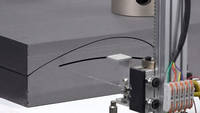
1. De vleugel profileren met een hetedraadknipper
Het kernmateriaal dat gebruikt wordt voor deze vleugel is XPS of geëxtrudeerd polystyreen dat een gladde afwerking heeft wanneer het gesneden wordt in plaats van polystyreen met kralen. Het heeft ook betere mechanische prestaties.
Hoewel het XPS met de hand kan worden gesneden, is het niveau van nauwkeurigheid vrij laag. De meest efficiënte manier is om een handgebogen draadsnijder te gebruiken, die nauwkeurige vleugelprofielen geeft. In dit geval gebruiken we een 4-assige CNC hogedraadfrees die we al hadden. Hoewel we voor deze profielen alleen de 2-assige functie gebruiken.
Een belangrijk punt bij een draadsnijder is om niet te snel te knippen. Als je te snel knipt, zal de draad slepen en dit kan het knipprofiel vervormen. De snelheid moet zo worden ingesteld dat het schuim net voor de draad smelt en de draad het schuim niet raakt. Als ruwe richtlijn werden deze profielen gesneden met een snelheid van 200 mm per minuut. Eenmaal gesneden kunnen de profielen uit het schuimblok worden gehaald, klaar om de vleugel te maken.
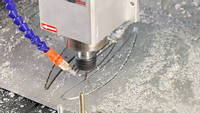
2. Hardpoints en inzetstukken maken en aanbrengen
Om de vleugel te bevestigen is het essentieel om inserts of harde punten te hebben voor de bevestigingen, omdat het composiet en schuim de belasting niet voldoende zouden opnemen. Om deze te maken is 8mm aluminium plaat CNC bewerkt, hoewel het ook met de meest gangbare gereedschapsmachines gesneden zou kunnen worden als er geen CNC beschikbaar was en zelfs in MDF gemaakt voor eenvoudige toepassingen.
De gesneden inzetstukken worden geschuurd en vervolgens gereinigd met aceton om ze te ontvetten voordat ze met Permabond ET500 Adhesive op de schuimkuur worden gelijmd. Hiermee worden de schuimdelen aan elkaar gelijmd. Zorg ervoor dat er geen kieren of richels zijn, want die kunnen op het vleugeloppervlak drukken. In dit stadium kunnen eventuele kieren gemakkelijk worden opgevuld met de lijm.
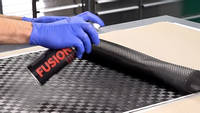
3. Materialen voorbereiden voor de vleugelconstructie
Mylar folie is de sleutel tot dit proces. Het kleeft niet en heeft in de hier gebruikte dikte van 125 micron de juiste balans tussen flexibiliteit en oppervlakteafwerking voor de vleugeltoepassing. De Mylar moet nauwkeurig op lengte worden afgemeten ten opzichte van de kern. De reden hiervoor zal duidelijker worden als de vleugel wordt gefabriceerd. In de andere richting wordt het Mylar 50 mm overmaats gesneden om een overlap aan de achterrand te geven.
Een vacuümzak wordt gebruikt om de vleugel te verstevigen en samen te drukken terwijl hij uithardt. De zak moet in dit stadium van tevoren worden voorbereid, waarbij één kant open moet blijven voor het plaatsen van de vleugel. De andere zijden kunnen worden afgedicht met gomtape en de doorvoerconnector kan vooraf worden geïnstalleerd.
De wapening wordt nu voorbereid door deze in vorm te snijden en klaar te maken voor gebruik. De cosmetische laag aan het oppervlak is onze 88g Spread touw koolstofvezel, die een zeer vlakke afwerking heeft en er cosmetisch prachtig uitziet. Spread touw stoffen zijn echter erg kwetsbaar als ze eenmaal gesneden zijn en rafelen gemakkelijk als je ze vastpakt. Om dit probleem te voorkomen, is op alle snijlijnen afplaktape aangebracht om de stof bij elkaar te houden. De stof is in beide richtingen ongeveer 20 mm te groot. De rest van de versteviging bestaat uit 3 lagen van het 210 g keper geweven koolstofvezeldoek.
Om de Spread touw nog meer te stabiliseren, wordt de stof bespoten met Fusion Fix kleefspray en wordt één laag van de achterkantstof voorzichtig over de Spread touw gerold om deze te stabiliseren. Een plastic rol met lamellen wordt gebruikt om ervoor te zorgen dat de twee lagen goed op elkaar aansluiten. De stof kan vervolgens worden opgerold met een papieren scheider, klaar voor gebruik.
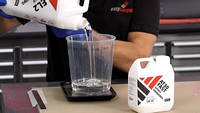
4. De hars afmeten en mengen
Voor dit project is de ideale hars de EL2 Epoxy Lamineerhars. Het heeft de juiste balans tussen een gemiddelde viscositeit en goede mechanische prestaties voor dit proces. Om de juiste hoeveelheid hars te bepalen, weeg je eerst de totale hoeveelheid weefselwapening af die voorgeknipt is.
Vanwege de hars die nodig is voor de Mylar film en het feit dat overtollige hars eruit wordt geperst, wordt er meer hars gebruikt dan gebruikelijk is bij een nat legproces. Neem de hierboven gemeten hoeveelheid en verdubbel deze, zodat er twee keer zoveel hars wordt gebruikt als het gewicht van de vezel.
Zoals bij alle composieten is het belangrijk om de hars zorgvuldig af te wegen volgens de mengverhouding op de flessen en vervolgens grondig te mengen voor gebruik. Het wordt aanbevolen om enkele minuten te mengen in één emmer, voordat je het in een tweede schone emmer giet en opnieuw mengt.
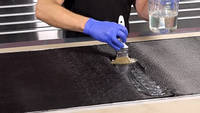
5. De hars aanbrengen en de wapening lamineren
In dit stadium wordt ongeveer een derde van de hars op de Mylar film gegoten en in een gelijkmatige laag uitgesmeerd. De eerste laag wapening wordt dan voorzichtig op de hars gelegd en de plastic vinnenroller wordt over het oppervlak gebruikt. Door op deze manier heen en weer te bewegen met de plastic vinnenroller wordt de hars nat gemaakt door de vezels en baant het zich een weg door de wapening. Dit resulteert in een beter geconsolideerd materiaal en minder ingesloten lucht dan wanneer er van achteren wordt gewerkt.
Zodra het oppervlak volledig is omgewalst, kan er meer hars worden aangebracht en kan het proces worden herhaald voor de resterende versterkingslagen. Het is belangrijk dat de harslaag gelijkmatig over het hele oppervlak wordt verspreid. De laatste laag moet er na volledig omrollen vrij nat uitzien. Deze overtollige hars helpt bij het aanbrengen van de kern op de wapening, waardoor deze en de Mylar kunnen glijden en bewegen als dat nodig is. Hoewel rollers ideaal zijn voor dit proces, kunnen spreiders of een kwast voorzichtig worden gebruikt om hetzelfde effect te bereiken.
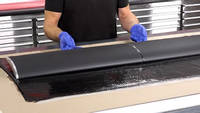
6. De kern plaatsen en inpakken in Mylar
Nu de wapening volledig is bevochtigd, kan de kern voorzichtig op de wapening worden geplaatst. De Mylar-folie wordt dan om de kern gewikkeld en de positie van de kern kan worden aangepast om deze mooi in het midden te krijgen. Het is normaal dat de Mylar en de stof in dit stadium vrij los tegen de kern aanliggen. De Mylar wordt dan afgeveegd om overtollige hars te verwijderen en de vleugel wordt in de vacuümzak geplaatst.
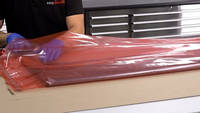
7. De vleugel vacuüm zuigen
De vleugel wordt nu voorzichtig in de voorgemaakte vacuümzak geplaatst. De vleugel moet zo worden geplaatst dat de vleugelvoorrand tegen de vouw in de vacuümzak wordt gedrukt. De folie kan dan worden strakgetrokken en langs het vleugeloppervlak worden gladgestreken om overtollige folie en vouwen te verwijderen.
Vervolgens wordt een strook zwaargewicht breather over de achterrand van de vleugel geplaatst en kan de gomtape worden geseald. Het vacuüm kan nu op de zak worden getrokken.
Het is belangrijk om geleidelijk aan het vacuüm te trekken en regelmatig te stoppen om plooien uit de Mylar film te verwijderen en overtollige hars te verwijderen door voorzichtig over de oppervlakken van de vleugel te wrijven. Een ideaal hulpmiddel om als zuigmond te dienen is een stuk van het schuim met wat ademend doek over de rand.
Zodra de overtollige hars is verwijderd en de Mylar vlak en kreukvrij zit, kan het volledige vacuüm worden toegepast en kan de zak uitharden. De zak moet zo worden gelegd dat de achterrand recht uit het profiel komt.
Het tweede element wordt op precies dezelfde manier geproduceerd als het eerste. Deze lay-up is geoptimaliseerd voor eenvoud en kan op veel manieren worden verbeterd. De eerste methode zou zijn om liggers in de kern van de vleugel op te nemen. Dit betekent dat de huid dunner kan zijn, waardoor het gewicht afneemt. Een eenvoudige methode is om het schuim verticaal door te snijden en er een voorgemaakt stuk koolstofplaat in te plakken. Het kan verder worden verbeterd door het gebruik van eindkappen en ribben.
De lay-up zelf kan nog verder worden verbeterd. Een eenvoudige layup van 0 en 90 graden is niet de meest efficiënte layup en kan worden verbeterd met een meer zorgvuldige laminaatoriëntatie en layup.
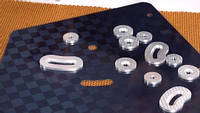
8. De eindplaat voorbereiden
Aangezien de eindplaten de belasting van de vleugel naar het chassis overbrengen, moeten ze zeer sterk worden geconstrueerd. Voor dergelijke toepassingen is een sandwichpaneelconstructie ideaal. In dit voorbeeld worden 2 lagen van een 1 mm Spread touw koolstofvezelplaat aan weerszijden van een 5 mm Nomex honingraatkernmateriaal geklemd.
De koolstofplaat wordt in vorm gesneden met onze CNC-router, hoewel dit ook met de hand kan als deze niet beschikbaar is. Het carbon snijdt heel zuiver zonder dat verdere afwerking nodig is. Als snijgereedschap wordt een hardmetalen stiftfrees van 1,6 mm gebruikt, die de koolstofplaat snel en gemakkelijk snijdt. Er moet gebruik worden gemaakt van volledige stofafzuiging om het gevaar van stof in de lucht te beperken.
In dit stadium moeten de inzetstukken worden gemaakt. Overal waar bevestigingen door de eindplaat gaan, zijn er hoge drukbelastingen die de kern kunnen verbrijzelen en beschadigen. De inzetstukken, meestal gemaakt van aluminium, spreiden de belasting en voorkomen dat de kern verbrijzelt. Deze inzetstukken zijn machinaal uit aluminium vervaardigd en CNC-gesneden. Voor eenvoudige toepassingen kunnen ze zelfs van MDF worden gemaakt.
Het hechtoppervlak van de inzetstukken wordt met schuurpapier geslepen en de inzetstukken worden gereinigd en ontvet. Daarna kunnen ze op hun plaats worden gelijmd op de koolstofplaat met de VM100 zwarte lijm. De peel ply textuur aan de achterkant van de koolstofplaat is ideaal om op te kleven en behoeft dus geen verdere voorbereiding.
Wanneer aluminium direct op koolstofvezel wordt verlijmd, is het belangrijk om te overwegen of galvanische corrosie een probleem kan zijn voor de specifieke toepassing. In dit geval gaat het om een droog opgeslagen raceauto en is er dus geen probleem, zodat er geen actie hoeft te worden ondernomen. Maar voor sommige andere toepassingen, zoals marine of luchtvaart, is het belangrijk om het aluminium te isoleren van het koolstof. Dit gaat het gemakkelijkst door er een dunne laag glasvezel tussen te lamineren.
De Nomex honingraat kan nu voorzichtig in vorm worden gesneden met een scalpel. De rand van de Nomex wordt iets korter gesneden dan de rand van de eindplaat, zodat er een kleine opening ontstaat die kan worden opgevuld voor het afdichten van de paneelrand. Het snijden rond de inzetstukken is ook een gemakkelijke taak met de mogelijkheid om de honingraat zijwaarts licht te vervormen om een strakke pasvorm tegen de inzetstukken te krijgen.
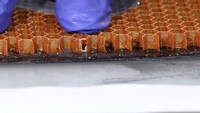
9. De eindplaten aan elkaar lijmen
In dit stadium zijn de eindplaatcomponenten klaar om aan elkaar te worden gelijmd tot het uiteindelijke afgewerkte onderdeel. Hiervoor wordt de ER1 Epoxy Rapid Repair hars gebruikt als lijm. Dit vanwege zijn goede mechanische prestaties en relatief snelle uithardingstijd. Om het geschikt te maken voor gebruik is het nodig om het harssysteem in te dikken tot een hechtende consistentie met behulp van thixotroop poeder van pyrogeen kiezelzuur.
De hars wordt zoals gewoonlijk afgemeten en dan wordt de pyrogene silica geleidelijk aan de hars toegevoegd om het in te dikken. Het doel is om het in te dikken tot de consistentie van een typische gelcoat. Zodra dit is bereikt, kan de verharder worden toegevoegd en de hars grondig worden gemengd voor gebruik.
De hars wordt dan gelijkmatig verdeeld over beide koolstofplaten in een hoeveelheid van ongeveer 500 g per vierkante meter. Een spreider met inkepingen werkt hier goed voor of zelfs een kwast op kleinere stukken zoals deze. De Nomex wordt dan op het carbon geplaatst en in beide richtingen opzij geschoven. Hierdoor kan de hars een fillet vormen op de zijwanden van het honingraatpapier om het hechtoppervlak aanzienlijk te vergroten.
In dit stadium worden de eindplaten vacuüm gezogen om een gelijkmatige kracht op het paneel uit te oefenen. Er wordt een MDF-spreider gebruikt om ervoor te zorgen dat de randen van het paneel niet vervormen waar er een opening in de honingraat zit. Het is belangrijk om in dit geval slechts een gedeeltelijk vacuüm te gebruiken via een vacuümregelaar. Als er volledig vacuüm wordt gebruikt, kan dit problemen veroorzaken doordat alle hars uit de rand van de panelen wordt geperst en kan de lijm overmatig gaan borrelen of schuimen als de lucht naar buiten komt. Daarom is slechts ongeveer 20% vacuüm nodig. Met behulp van een vacuümregelaar kan dit gemakkelijk op het ideale niveau worden ingesteld. De eindplaten kunnen dan 6 uur onder vacuüm uitharden voordat ze uit de zak worden gehaald.
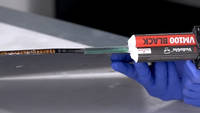
10. De randen van de eindplaten afdichten
Nu de eindplaten uitgehard zijn, kunnen ze uit de zakjes gehaald worden. Om de rand te verzegelen, knijp je VM100 Black lijm in de rand. De snelle uithardingstijd, hoge viscositeit en het schuurgemak maken het ideaal voor deze toepassing.
Als de rand eenmaal gevuld is, kan deze worden geëgaliseerd met behulp van een vlakke rand van een spreider en vervolgens laten uitharden. Na uitharding kunnen de randen glad worden geschuurd om ze af te werken. Door te schuren tot korrel 800 krijg je een mooie egale en nette afwerking van de rand.
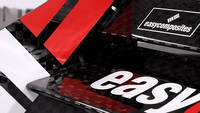
11. Definitieve afwerking en assemblage van de vleugel
In dit stadium moeten de vleugelelementen volledig uitgehard zijn en kunnen ze uit de vacuümzak worden gehaald. De lossende eigenschappen van de Mylar komen hier goed tot uiting omdat het gemakkelijk van het vleugeloppervlak afbladdert en de gladde glanzende afwerking van de vleugel blootlegt.
De randen en uiteinden van de vleugel kunnen nu worden opgeruimd, klaar voor montage, en eventuele gaten kunnen worden getapt om schroefdraad toe te voegen. De blauwe folie kan van de eindplaten worden verwijderd en eventuele stickers en decals kunnen worden aangebracht. De vleugelelementen worden dan eenvoudig in elkaar geschroefd tot de afgewerkte vleugel met dubbele elementen.
Nu kun je de afgewerkte vleugel zien en de kwaliteit straalt er vanaf. Door het gebruik van een lichte schuimkern en koolstofvezel is het totale gewicht van deze vleugel slechts 3,5 kg en hij is meer dan sterk genoeg voor de hoeveelheid downforce die hij kan produceren. We hebben een video gemaakt waarin we aan de hand van destructieve tests laten zien hoe sterk deze vleugel is!
De eindplaten hebben een hoge productiekwaliteit en vooral de VM100 laat een mooie rand achter. Het Mylar laat een zeer hoogglanzende afwerking achter op de vleugelelementen. Het belangrijkste compromis van deze manier van vleugelconstructie is de vlakheid van het oppervlak dat bereikt kan worden met de Mylar folie. Er is altijd een element van rimpeling in het vleugeloppervlak, hoewel dit geen invloed heeft op de werkelijke prestaties van de vleugel. Ook zal deze methode leiden tot een iets zwaardere vleugel door de grotere hoeveelheid hars die gebruikt wordt. Per saldo is het echter nog steeds een zeer goede methode om een eenmalige vleugel of een vleugel met een laag volume te maken.
DISCUSSIE (25)
Laat het ons weten als je vragen of opmerkingen hebt over deze videotutorial.
Dezelfde methode zou moeten werken zolang je kern sterk genoeg is, experimenteer bijvoorbeeld met geprinte vulling enz. Voor een complexe vorm zul je bijna zeker problemen hebben met vouwen als je een enkel stuk mylar gebruikt, omdat het niet gemakkelijk uitrekt of zich vormt over complexe rondingen. Het kan zijn dat je moet snijden en overlappen om vouwen te verwijderen en je kunt verwachten dat je het een beetje moet bijwerken.
Dat is handig om te weten dat het goed werkte voor jouw toepassing met dikker Mylar. De versteviging die in de video werd getoond was een eenvoudige lay-up die goed werkte, maar kan verder worden verfijnd zoals vermeld, dus de extra strook versteviging rond de voorrand is een goede manier om de lay-up voor het zweefvliegtuig te optimaliseren.
Je hebt natuurlijk 100% gelijk. We noemen dit als een tekortkoming van deze methode (net als de oppervlakte rimpeling), maar de eenvoud van deze methode en het gemak voor eenmalige toepassingen betekent dat de voordelen voor veel mensen veel zwaarder wegen dan het gewicht. Veel FSAE-teams en soortgelijke teams hebben krappe budgetten en krappe ontwikkelingstijden en daarom is het compromis in gewicht soms de moeite waard.
Als je goed kijkt, zie je de ontluchter over de achterrand en ook onder de Through Bag Connector. Dat is genoeg lucht om ingesloten lucht uit het laminaat te laten ontsnappen.
Dat is erg chassisspecifiek, daarom hebben we het hier niet behandeld.
In theorie zou je koolstofvezel om de meeste kernmaterialen kunnen wikkelen, maar dat is niet noodzakelijk de meest efficiënte manier om het onderdeel te maken, maar als de vorm het gebruik van dat materiaal vereist, zou het moeten werken.
Het hangt ervan af of het vleugelontwerp parallel is (of complexere samengestelde vormen heeft) en ook of het ontwerp van de mal je toegang geeft tot de uiteinden (m.a.w. de mallen zijn open). Als het parallel en open is, kunt u de boven- en onderkant op elkaar leggen, ze dan 'nat' bij elkaar brengen en voorzichtig extra natte wapening over de verbinding aanbrengen. Als je geen toegang hebt via de uiteinden dan moet je meestal de twee helften apart maken en ze daarna aan elkaar lijmen.
De tape wordt niet verwijderd. Omdat de stof iets te groot is gemaakt, worden de randen met de tape aan het einde van de productie van de vleugels afgesneden.
Er zijn geen 'rimpels' omdat het Mylar niet gevouwen of gekreukt is, maar er zijn wel rimpelingen/schommelingen, die we eerlijk behandelen in de roundup, inclusief het pannen van de camera langs de vleugel om de rimpelingen te laten zien.
Zweefvliegtuigen zijn een goed onderwerp om veel interessante en belangrijke concepten te demonstreren, net als elke vliegtuigvleugel. Op de hotwire wordt het hele profiel in één keer gesneden, de nauwkeurigheid van de boven- en onderkant moet allebei erg goed zijn (meer dan genoeg voor dit proces); we zien minder dan 0,5 mm tolerantie.
Het was opgesteld als een generieke vleugel in plaats van iets specifieks. De specifieke profielen die werden gebruikt waren echter 'Eppler423' voor het hoofdelement en 'NACA4412' voor het secundaire element.
Als je het hebt over de rimpelingen/schommelingen in het oppervlak, dan heeft dat meer te maken met de wapening die aan de buitenkant is toegevoegd (en de variërende hoeveelheden hars) dan met de inconsistentie/onregelmatigheid van de kern, dus ik denk niet dat de rimpeling zou kunnen worden verbeterd door een 3D-geprinte kern en het zou moeilijk zijn om een kern te printen die in de buurt komt van de lage dichtheid van XPS (die ongeveer 25 kg/m3 of (aka een dichtheid van 0,025).
Hoi Keith, ja, het biedt een veel beter uitgangspunt in termen van oppervlakteafwerking. Het is zeker niet perfect, zoals we in de video hebben besproken, maar voor veel toepassingen is het meer dan goed genoeg en betekent het heel weinig werk aan het oppervlak.
Hoi Rolf, we vroegen ons precies dit af. Dus we hebben het geprobeerd! En .... het werkte niet echt! De kleine variatie in dikte van de wapening veroorzaakte te veel gebieden die niet genoeg consolidatiedruk kregen. Er kunnen enkele wijzigingen in het proces zijn die dingen zouden verbeteren, maar van wat we hebben gevonden, was het schuim 'uitgesneden' niet wat we hoopten dat het zou zijn!
Hoi Matt, stem genoteerd! Wij willen het ook doen. Heb de volgende paar al op een rijtje gezet, maar blijf gesubbed en hopelijk komen we er snel aan toe!
Nee, zelfs bij volledig vacuüm is XPS prima. Geëxpandeerd polystyreen zou het niet aankunnen, maar we zouden EPS sowieso niet aanraden.
Bedankt voor de opmerking, ik geef er de voorkeur aan om eerst de bovenkant te snijden omdat anders de gewichten op het schuim het hele blok laten doorhangen, wat betekent dat de bovenkant een beetje verschuift. Ik heb nog nooit een probleem gehad met waar de draad uitkomt, maar ik weet zeker dat er momenten kunnen zijn waarop het beter is om eerst de onderkant te snijden.
Ze zijn vergelijkbaar in termen van druksterkte per gram en dus is het verschil (en de voorkeur) genuanceerder. Voor deze eindplaten is de pure kracht vrij beperkt en dus zou de kern met de laagste dichtheid de beste optie zijn. Aangezien het moeilijk is om de lage dichtheid van een nomex kern te evenaren in aluminium, gaat de voorkeur hier uit naar nomex.
We hebben een paar keer geoefend met het kleinere element, gewoon om het proces aan te scherpen, maar dat was het wel zo'n beetje. Het is moeilijk om te zeggen hoeveel tijd het van begin tot eind heeft gekost, maar exclusief het maken van de hotwire, waren we in 3 dagen klaar met filmen, en het grootste deel van die tijd bestond uit het uitharden van de dingen, dus gezien de grootte en complexiteit van het onderdeel, zou ik zeggen dat het vrij weinig uren waren. Ik reken de ontwerptijd daar ook niet bij.
Er zijn VEEL manieren om gewicht uit dit onderdeel te halen, maar ze voegen allemaal complexiteit toe en kunnen het risico inhouden dat het onderdeel defect raakt. Dit project is niet geoptimaliseerd voor gewicht, maar het is erg vergevingsgezind en zal bijna zeker een sterk onderdeel produceren met een aanvaardbaar laag gewicht.
Het overleeft perfect, dus ja, je kunt de Mylar zeker hergebruiken.
Hoi Nathan, ja, zeker weten. Het is niet echt anders dan wat we hier doen, op voorwaarde dat de vorm van de spoiler een parallel profiel is.
Voor de vleugels zou het proces erg op elkaar lijken. Vleugels van RC-vliegtuigen worden al vele jaren gemaakt met behulp van XPS met hete bedrading, bedekt met koolstof of glas, bevochtigd met epoxy. Andere onderdelen, zoals de romp, worden meestal gemaakt met een hand layup van gelcoat, dan koolstof of glas en hars, soms (maar niet altijd) vacuüm verpakt. Bekijk ons RAMY RC's kanaal om een meestervakman te zien die RC vliegtuigen bouwt.
We hebben een interessant proces voor samengestelde krommingen en willen dit graag delen in een toekomstige video, dus blijf kijken.
Inderdaad, er zijn een aantal situaties waarin het maken van een harspasta met gemiddelde dichtheid (kiezelzuur voor de thixotrope eigenschap en glasbelletjes om de dichtheid te verminderen) een goede optie kan zijn. Andere lichtere materialen kunnen ook worden vervangen door het zwaardere aluminium, vooral als je de legering niet aftapt.
LAAT EEN OPMERKING OF VRAAG ACHTER
PRODUCTEN GEBRUIKT IN DIT PROJECT
Hoewel dit niet per se een uitputtende lijst is, werden de volgende gereedschappen en materialen, geleverd door Easy Composites, in dit project gebruikt.
De hoeveelheid die hieronder wordt weergegeven, is de geschatte hoeveelheid die in het project wordt gebruikt, afgerond naar de dichtstbijzijnde beschikbare kitgrootte of hoeveelheid.
MATERIALEN & VERBRUIKSARTIKELEN








GEREEDSCHAP & UITRUSTING



VERBRUIKSARTIKELEN VOOR VACUÜMZAKKEN



ANCILLARIES



VERSTERKINGEN


DISCUSSIE (25)
Laat het ons weten als je vragen of opmerkingen hebt over deze videotutorial.
Dezelfde methode zou moeten werken zolang je kern sterk genoeg is, experimenteer bijvoorbeeld met geprinte vulling enz. Voor een complexe vorm zul je bijna zeker problemen hebben met vouwen als je een enkel stuk mylar gebruikt, omdat het niet gemakkelijk uitrekt of zich vormt over complexe rondingen. Het kan zijn dat je moet snijden en overlappen om vouwen te verwijderen en je kunt verwachten dat je het een beetje moet bijwerken.
Dat is handig om te weten dat het goed werkte voor jouw toepassing met dikker Mylar. De versteviging die in de video werd getoond was een eenvoudige lay-up die goed werkte, maar kan verder worden verfijnd zoals vermeld, dus de extra strook versteviging rond de voorrand is een goede manier om de lay-up voor het zweefvliegtuig te optimaliseren.
Je hebt natuurlijk 100% gelijk. We noemen dit als een tekortkoming van deze methode (net als de oppervlakte rimpeling), maar de eenvoud van deze methode en het gemak voor eenmalige toepassingen betekent dat de voordelen voor veel mensen veel zwaarder wegen dan het gewicht. Veel FSAE-teams en soortgelijke teams hebben krappe budgetten en krappe ontwikkelingstijden en daarom is het compromis in gewicht soms de moeite waard.
Als je goed kijkt, zie je de ontluchter over de achterrand en ook onder de Through Bag Connector. Dat is genoeg lucht om ingesloten lucht uit het laminaat te laten ontsnappen.
Dat is erg chassisspecifiek, daarom hebben we het hier niet behandeld.
In theorie zou je koolstofvezel om de meeste kernmaterialen kunnen wikkelen, maar dat is niet noodzakelijk de meest efficiënte manier om het onderdeel te maken, maar als de vorm het gebruik van dat materiaal vereist, zou het moeten werken.
Het hangt ervan af of het vleugelontwerp parallel is (of complexere samengestelde vormen heeft) en ook of het ontwerp van de mal je toegang geeft tot de uiteinden (m.a.w. de mallen zijn open). Als het parallel en open is, kunt u de boven- en onderkant op elkaar leggen, ze dan 'nat' bij elkaar brengen en voorzichtig extra natte wapening over de verbinding aanbrengen. Als je geen toegang hebt via de uiteinden dan moet je meestal de twee helften apart maken en ze daarna aan elkaar lijmen.
De tape wordt niet verwijderd. Omdat de stof iets te groot is gemaakt, worden de randen met de tape aan het einde van de productie van de vleugels afgesneden.
Er zijn geen 'rimpels' omdat het Mylar niet gevouwen of gekreukt is, maar er zijn wel rimpelingen/schommelingen, die we eerlijk behandelen in de roundup, inclusief het pannen van de camera langs de vleugel om de rimpelingen te laten zien.
Zweefvliegtuigen zijn een goed onderwerp om veel interessante en belangrijke concepten te demonstreren, net als elke vliegtuigvleugel. Op de hotwire wordt het hele profiel in één keer gesneden, de nauwkeurigheid van de boven- en onderkant moet allebei erg goed zijn (meer dan genoeg voor dit proces); we zien minder dan 0,5 mm tolerantie.
Het was opgesteld als een generieke vleugel in plaats van iets specifieks. De specifieke profielen die werden gebruikt waren echter 'Eppler423' voor het hoofdelement en 'NACA4412' voor het secundaire element.
Als je het hebt over de rimpelingen/schommelingen in het oppervlak, dan heeft dat meer te maken met de wapening die aan de buitenkant is toegevoegd (en de variërende hoeveelheden hars) dan met de inconsistentie/onregelmatigheid van de kern, dus ik denk niet dat de rimpeling zou kunnen worden verbeterd door een 3D-geprinte kern en het zou moeilijk zijn om een kern te printen die in de buurt komt van de lage dichtheid van XPS (die ongeveer 25 kg/m3 of (aka een dichtheid van 0,025).
Hoi Keith, ja, het biedt een veel beter uitgangspunt in termen van oppervlakteafwerking. Het is zeker niet perfect, zoals we in de video hebben besproken, maar voor veel toepassingen is het meer dan goed genoeg en betekent het heel weinig werk aan het oppervlak.
Hoi Rolf, we vroegen ons precies dit af. Dus we hebben het geprobeerd! En .... het werkte niet echt! De kleine variatie in dikte van de wapening veroorzaakte te veel gebieden die niet genoeg consolidatiedruk kregen. Er kunnen enkele wijzigingen in het proces zijn die dingen zouden verbeteren, maar van wat we hebben gevonden, was het schuim 'uitgesneden' niet wat we hoopten dat het zou zijn!
Hoi Matt, stem genoteerd! Wij willen het ook doen. Heb de volgende paar al op een rijtje gezet, maar blijf gesubbed en hopelijk komen we er snel aan toe!
Nee, zelfs bij volledig vacuüm is XPS prima. Geëxpandeerd polystyreen zou het niet aankunnen, maar we zouden EPS sowieso niet aanraden.
Bedankt voor de opmerking, ik geef er de voorkeur aan om eerst de bovenkant te snijden omdat anders de gewichten op het schuim het hele blok laten doorhangen, wat betekent dat de bovenkant een beetje verschuift. Ik heb nog nooit een probleem gehad met waar de draad uitkomt, maar ik weet zeker dat er momenten kunnen zijn waarop het beter is om eerst de onderkant te snijden.
Ze zijn vergelijkbaar in termen van druksterkte per gram en dus is het verschil (en de voorkeur) genuanceerder. Voor deze eindplaten is de pure kracht vrij beperkt en dus zou de kern met de laagste dichtheid de beste optie zijn. Aangezien het moeilijk is om de lage dichtheid van een nomex kern te evenaren in aluminium, gaat de voorkeur hier uit naar nomex.
We hebben een paar keer geoefend met het kleinere element, gewoon om het proces aan te scherpen, maar dat was het wel zo'n beetje. Het is moeilijk om te zeggen hoeveel tijd het van begin tot eind heeft gekost, maar exclusief het maken van de hotwire, waren we in 3 dagen klaar met filmen, en het grootste deel van die tijd bestond uit het uitharden van de dingen, dus gezien de grootte en complexiteit van het onderdeel, zou ik zeggen dat het vrij weinig uren waren. Ik reken de ontwerptijd daar ook niet bij.
Er zijn VEEL manieren om gewicht uit dit onderdeel te halen, maar ze voegen allemaal complexiteit toe en kunnen het risico inhouden dat het onderdeel defect raakt. Dit project is niet geoptimaliseerd voor gewicht, maar het is erg vergevingsgezind en zal bijna zeker een sterk onderdeel produceren met een aanvaardbaar laag gewicht.
Het overleeft perfect, dus ja, je kunt de Mylar zeker hergebruiken.
Hoi Nathan, ja, zeker weten. Het is niet echt anders dan wat we hier doen, op voorwaarde dat de vorm van de spoiler een parallel profiel is.
Voor de vleugels zou het proces erg op elkaar lijken. Vleugels van RC-vliegtuigen worden al vele jaren gemaakt met behulp van XPS met hete bedrading, bedekt met koolstof of glas, bevochtigd met epoxy. Andere onderdelen, zoals de romp, worden meestal gemaakt met een hand layup van gelcoat, dan koolstof of glas en hars, soms (maar niet altijd) vacuüm verpakt. Bekijk ons RAMY RC's kanaal om een meestervakman te zien die RC vliegtuigen bouwt.
We hebben een interessant proces voor samengestelde krommingen en willen dit graag delen in een toekomstige video, dus blijf kijken.
Inderdaad, er zijn een aantal situaties waarin het maken van een harspasta met gemiddelde dichtheid (kiezelzuur voor de thixotrope eigenschap en glasbelletjes om de dichtheid te verminderen) een goede optie kan zijn. Andere lichtere materialen kunnen ook worden vervangen door het zwaardere aluminium, vooral als je de legering niet aftapt.
LAAT EEN OPMERKING OF VRAAG ACHTER
100% BEVEILIGD
BETALINGSMETHODEN
Easy Composites EU B.V., geregistreerd in Nederland 73601195. Alle inhoud auteursrechtelijk beschermd (C) Easy Composites Ltd, 2025. Alle rechten voorbehouden.
